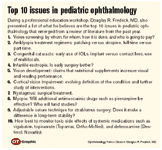Article
Controversy swirls around mandatory eye exams for kids
In the field of glaucoma therapy, a study onthe measurement of central corneal thickness suggested that clinicians may be overestimating IOP in children with thick corneas.
Orlando-Childhood vision screening, approaches to amblyopia therapy and the age limits for treatment, trends in strabismus surgery, IOL implantation, and myopic progression were a few of the topics addressed in a professional education workshop at the American Association for Pediatric Ophthalmology and Strabismus annual meeting.

One of the most controversial topics discussed in the workshop was a paper on childhood vision screening. The paper by Donahue1 described eye examination results from children referred to local eye doctors following a statewide preschool photoscreening program. The author studied a subgroup of children who had low degrees of anisometropia, myopia, and hyperopia. All had eye exams, which were conducted by an optometrist, comprehensive ophthalmologist, or pediatric ophthalmologist.
This screening was performed in just one state, and if extrapolated nationwide, the data indicate that the cost of a mandatory eye examination before school entry could cost more than $200 million annually for unnecessary spectacles, Dr. Fredrick said.
Vision screening is one of the most hotly debated topics in ophthalmology as well as the subject of intensive debate in many states, with questions such as how it should be performed, by whom, which children should be screened, and how screening projects should be paid for, he added.
In refractive surgery news, authors of a study on children who had anisometropic amblyopia and were not compliant with spectacle therapy concluded that PRK could be safely performed and could play a role in the management of anisometropia in selected pediatric patients.2
Surgery was performed on 11 children who were not compliant with glasses, contact lenses, or occlusion therapy; the eye with the higher refractive error was treated with PRK using a standard adult nomogram. Postoperatively, 63% of the children saw within 2 D of the target refraction 12 months after surgery, and there was minimal corneal haze. The best spectacle-corrected visual acuity improved by 2 lines in 38% of children.
A study from India evaluated occlusion therapy in older children and found that it was an effective treatment for amblyopia in this age group (11 to 15).3
"The idea that you have to treat amblyopia by age 5 is not always true," Dr. Fredrick said.

A similar study from the Pediatric Eye Disease Investigator Group (PEDIG) analyzed amblyopia treatment in children age 10 to 18.4 In this pilot study, 66 children were treated with daily patching combined with at least 1 hour of near activities. When visual acuity was measured after 2 months, investigators found an improvement of 2 or more lines from baseline in 18 (27%) patients. They recommend a randomized controlled trial to determine if there is an upper limit at which amblyopia treatment can be successful.
Newsletter
Don’t miss out—get Ophthalmology Times updates on the latest clinical advancements and expert interviews, straight to your inbox.





